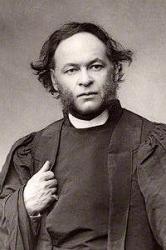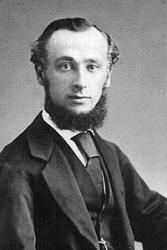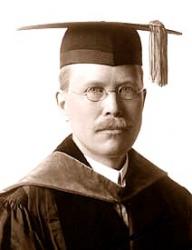Planning worship?
Check out our sister site, ZeteoSearch.org,
for 20+ additional resources related to your search.
- |
User Links
Person Results
‹ Return to hymnal




Export as CSV
Arthur Cottman
1842 - 1879 Hymnal Number: 213 Composer of "MIRFIELD" in Gloria Born: Circa November 1841, Ringwood, Hampshire, England.
Died: Circa May 1879, Brentford, Middlesex, England.
Cottman was a solicitor and amateur musician. His works include:
Ten Original Tunes, 1874
Music:
CATERHAM
COTTMAN
DALEHURST
EVERSLEY
MIRFIELD
MORN OF GLADNESS
--www.hymntime.com/tch
Arthur Cottman
William H. Walter
1825 - 1893 Hymnal Number: 216 Composer of "FESTAL SONG" in Gloria
William H. Walter
M. E. Thalheimer
Person Name: M. Elsie Thalheimer Hymnal Number: 284 Author of "Thou art my Shepherd" in Gloria
M. E. Thalheimer
Hugh R. Haweis

1838 - 1901 Person Name: Rev. Hugh R. Haweis Hymnal Number: 228 Author of "The Homeland! O the Homeland!" in Gloria Born: April 3, 1838, Egham, Surrey, England.
Died: January 29, 1901, St. Marylebone, London, England.
Haweis’ father was John Oliver Willyams Haweis, Canon of Chichester. Hugh attended Trinity College, Cambridge, and after graduation served under Garibaldi in the Italian war of independence. He was ordained in 1861 and was curate at Bethnal Green, Westminster and Stepney. In 1866, he became perpetual curate at St. James, Marylebone. His works include:
Music and Morals, 1871
My Musical Life, 1884
Travel and Talk, 1897
Old Violins, 1898
--www.hymntime.com/tch
Hugh R. Haweis
John M. Wigner

1844 - 1911 Hymnal Number: 108 Author of "Come to the Saviour now" in Gloria Wigner, John Murch, second son of J. T. Wigner, was born at Lynn, June 19, 1844. He was educated at the Grammar School of Lynn, and afterwards graduated B.A. and B.SC. in the London University. Mr. J. M. Wigner now resides near London, and has been for many years in the India Home Civil Service. He is connected with his father's church, and has done much to promote the spiritual welfare of the young. He is the author of several hymns, three of which are in the Baptist Psalms and Hymns for School and Home, 1882;—
1. "Come to the Saviour now!" Invitation.
2. "Lost one! wandering on in sadness." Return to God.
3. "Lo, a loving Friend is waiting." The Call of Jesus.
The first of these is in the Baptist Psalms & Hymns, 1880, and is dated 1871. [Rev. W.R. Stevenson, M.A.]
-- John Julian, Dictionary of Hymnology (1907)
John M. Wigner
Lawrence W. Watson
1860 - 1925 Hymnal Number: 208 Composer of "SALVE DOMINE" in Gloria
Lawrence W. Watson
Henry E. Matthews
b. 1820 Hymnal Number: 292 Composer of "CHILDREN'S PRAISES" in Gloria
Henry E. Matthews
Edith Sanford Tillotson

1876 - 1968 Hymnal Number: 260 Author of "Serve him, serve him, give him the best" in Gloria Edith Sanford Tillotson was born and lived her entire life in Corona, New York. She wrote hymns for children as well as poems and librettos.
Dianne Shapiro, from "The Singers and Their Songs: sketches of living gospel hymn writers" by Charles Hutchinson Gabriel (Chicago: The Rodeheaver Company, 1916)
Edith Sanford Tillotson
Charles Spurgeon Brown
1860 - 1943 Person Name: Charles S. Brown Hymnal Number: 251 Composer of "AMERICA, THE BEAUTIFUL" in Gloria Brown’s works include:
The King’s Praises (Boston, Massachusetts: United Society of Christian Endeavor, 1899)
www.hymntime.com/tch/
Charles Spurgeon Brown
Lindsay B. Longacre

1870 - 1952 Person Name: Rev. Lindsay B. Longacre Hymnal Number: 253 Composer of "NEW AMERICAN" in Gloria Lindsay Bartholomew Longacre was born in Pottsville, Pennsylvania, on January 26, 1870, the son of Orleans and Rachel (Bartholomew) Longacre. Longacre wanted to become a musician, but pursuant to his father’s wishes, he attended the Columbia University School of Mines and was graduated from there with a degree in mining engineering in 1892. Following a call to the ministry, he attended Drew Theological Seminary, where he received a B.D. degree in 1896, and was subsequently ordained a minister in the Methodist Church that same year.
From 1896-1910, Rev. Longacre served several small churches in the New York Conference.
These included Glenville, St. Luck, Madison Avenue (later called Christ Methodist after a move to a new location), Fifty-Sixth Street Church, Morris Heights, and Woodlawn Heights. His pastorate at Madison Avenue Church was as the Assistant Pastor to Andrew Longacre, his uncle.
In 1910, Dr. Longacre was appointed head of the Department of Old Testament Literature and Religion of the Iliff School of Theology. He held that position for 32 years. On several occasions during his tenure at Iliff, Dr. Longacre also acted as president of the school. He authored four books, a number of articles, and church school curriculum. His books are: A Prophet of the Spirit: A Sketch of the Character and Work of Jeremiah (1917 and 1922); Amos, Prophet of a New Order (1921; translated into Burmese in 1939); Deuteronomy, A Prophetic Lawbook (1924); and The Old Testament: Its Form and Purpose (1945). He was invited to submit three articles to the Abingdon Bible Commentary(1929). These articles are entitled “The Bible as Literature,” Numbers,” and “Joshua.” Dr. Longacre also held membership in the National Association of Biblical Instructors and the Society of Biblical Literature and Exegesis.
During his tenure at Iliff, Dr. Longacre was involved in a controversy known as the “fundamentalist-modernist controversy.” This controversy, which reached its height in the 1920s, grew out of reactions to the liberal approach that the school had taken toward religion and education. These reactions, from both inside and outside the Methodist Church, were in response to the school’s use of higher criticism in the teaching of Biblical studies.
While at Iliff, Dr. Longacre also taught courses in preaching, worship, and hymnology. He had nurtured his love for music as an avocation, and wrote many hymns and songs. Some of these hymns were published in The Riverdale Hymn Book (1912), The Methodist Hymnal (1935), The Hymnal (Evangelical and Reformed Church) (1941), and The Story of Our Hymns: The Handbook to the Hymnal of the Evangelical and Reformed Church (1952). He believed that great hymns were “God-centered.” In addition to composing music, he wrote explanatory notes for various Denver Symphony programs, and had a special love for opera. He also held membership in the Hymn Society of America, the American Guild of Organists, and the Quill Club of New York.
In his courses on worship, Dr. Longacre expected no loess that excellence from his students in planning and leading services. He felt that worship should be be “truly theocentric.” Because of his interests in music and worship, he served on the Commission on Ritual and Orders of Worship of the Methodist Church from 1940-44. The Commission produced a new Book of Worship for Church and Home. Dr. Longacre contributed introductory sentences to accompany selected readings in two sections: “Scriptures for Reading and Meditation” and “Daily Readings and Prayers for a Month.”
Dr. Longacre retired from Iliff in 1942. He and Florence Biggart Longacre, his second wife of six years, then made a brief move to California. (His first wife, Arabella Hyland Longacre, had passed away in 1930.) After returning to Denver, he played a leading role in the 1944 University of Denver production of Thornton Wilder’s Our Town. It was his first acting experience. That same year, the Longacre’s returned to New York City to pursue his interest in music and the arts through the cultural activities of the city. From 1947-1952, Dr. Longacre served as the Assistant Pastor to the Rev. Ralph W. Sockman of Christ Methodist Church.
Dr. Lindsay B. Longacre died at the age of 82 years on September 18, 1952, after a long and distinguished career of service to the church and humanity.
© 2002. Marshall Eidson
http://www.iliff.edu/research/archives/longacre/bio.htm
Lindsay B. Longacre


 My Starred Hymns
My Starred Hymns


